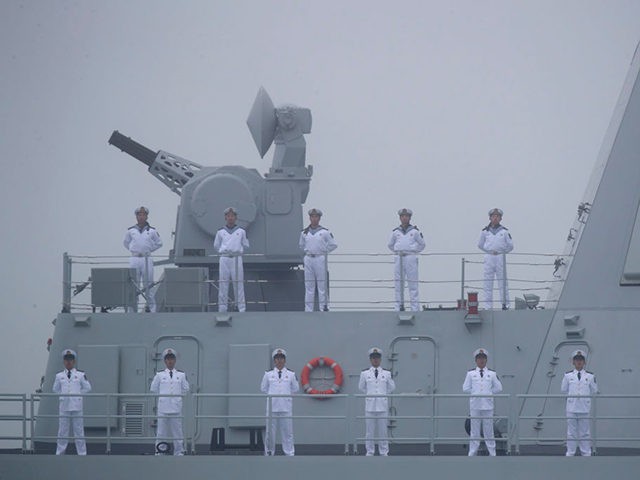China’s naval aviation forces held “live-fire maritime target attack drills” in the South China Sea involving “JH-7 fighter bombers” and deployed several warplanes to the disputed Paracel Islands late last week, Chinese state media reported on Monday.
The drills were reportedly held in an unspecified location by “[a] brigade under the [Chinese People’s Liberation Army] PLA Southern Theater Command Navy aviation forces based in South China’s Hainan Province” from July 15-17, the Chinese Communist Party newspaper Global Times revealed on Monday, citing a Sunday report by China National Radio.
The drills concluded on the same day, July 17, that “[e]ight Chinese fighter jets were visible” at China’s “key military base in the disputed Paracel Islands,” Radio Free Asia (RFA) reported Friday.
“Satellite imagery reviewed by RFA showed the Chinese planes on the runway at Woody Island. At least four of them appeared to be J-11Bs, which are fighter jets in service with the People’s Liberation Army Air Force (PLAAF) and Naval Aviation Force (PLANAF),” the news outlet reported. “The other four appear similar to and fit the dimensions of the JH-7, an anti-ship fighter-bomber in service with the PLAAF and PLANAF.”
RFA quoted military experts who said it was “the most fighter aircraft that have been spotted at one time at Woody Island, which is China’s largest military base and settlement in the Paracels, a grouping of features in the north of the South China Sea that is claimed by China, Vietnam, and Taiwan.”
“Military aircraft have shown up at Woody Island before, as have Chinese warships, most notably during China’s military exercises in the area from July 1-5,” RFA added.
Friday’s sighting of eight Chinese fighter jets on Woody Island “coincides with another round of naval exercises Thursday [July 16] involving two U.S. aircraft carrier battle groups — the USS Nimitz and USS Ronald Reagan. The first maneuvers began on July 4 and lasted six days, the first such ‘dual carrier drill’ by the U.S. in the South China Sea in at least four years,” RFA reports.
The U.S. Air Force deployed a B-52 bomber to join the aircraft carrier drill on July 4, provoking the ire of the PLA, which in response claimed to conduct its own regional drills over the same weekend.
On July 14, the U.S. performed a “freedom of navigation” exercise through the Philippines’ Spratly Islands, which China claims as its territory.
“The Arleigh Burke-class guided-missile destroyer USS Ralph Johnson (DDG 114) operated in the Spratly Islands [on] July 14. This freedom of navigation operation upheld the rights, freedoms, and lawful uses of the sea, recognized in international law,” the U.S. Pacific Fleet Public Affairs said in a July 15 statement.
On July 18, the South China Morning Post (SCMP) reported that the Chinese military has “successfully developed and tested an advanced air-to-ground missile for helicopters.”
“The new weapon was put through its paces at a desert location in the Inner Mongolia autonomous region in late June when it was fired from a helicopter and hit its intended target,” the SCMP writes, citing a report by China Aviation News.
“The missile, whose name and specifications were not revealed, is a stand-off weapon, meaning it can be launched from a distance sufficient to allow attacking personnel to evade defensive fire. With its multiple guided systems, long range, and capability to evade jamming, the missile is the first of its kind for China’s military,” the report stated.
“Once fully functional, the new missile could replace the AKD-9 and AKD-10 anti-tank missiles and YJ-9 anti-ship missiles already in service,” the report added.

COMMENTS
Please let us know if you're having issues with commenting.